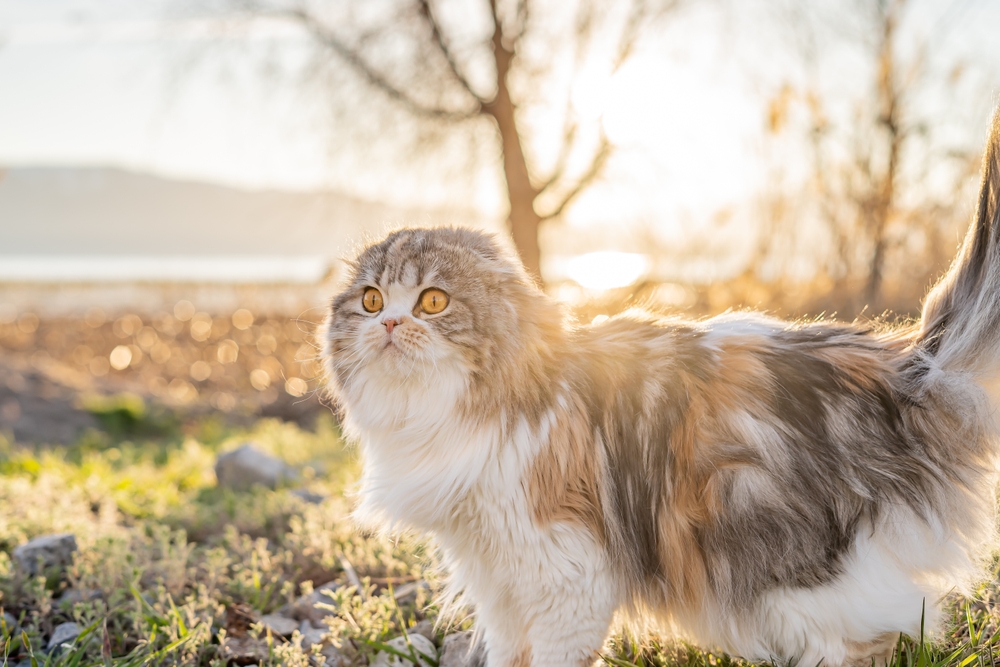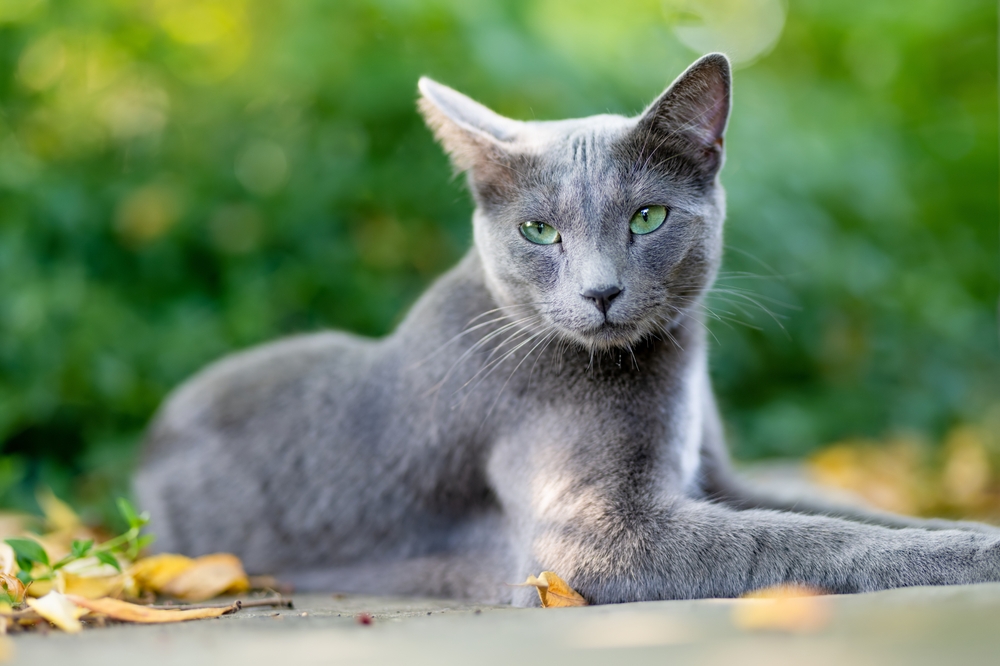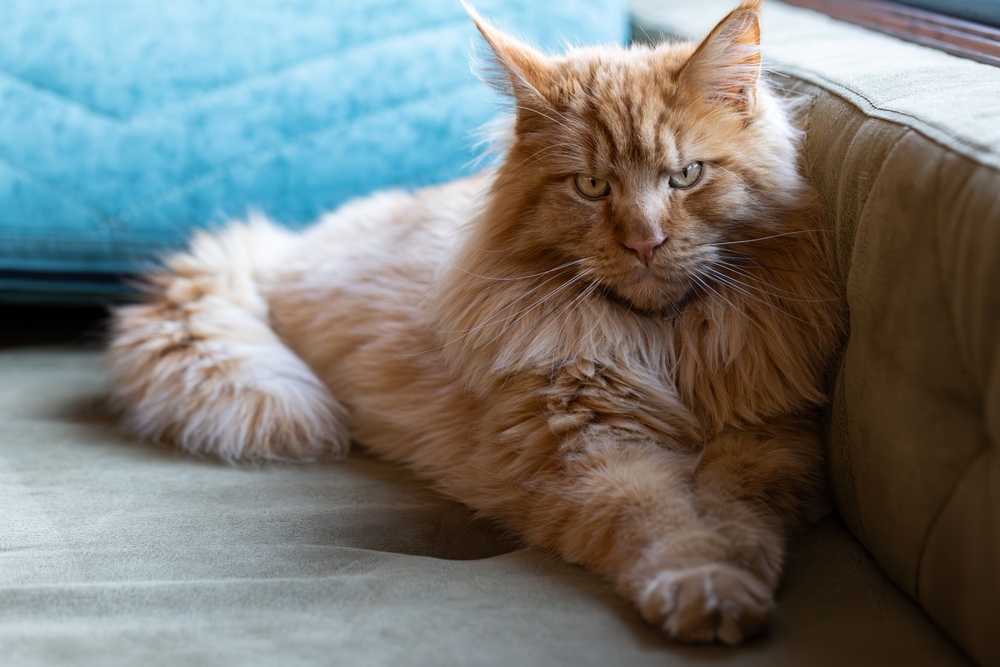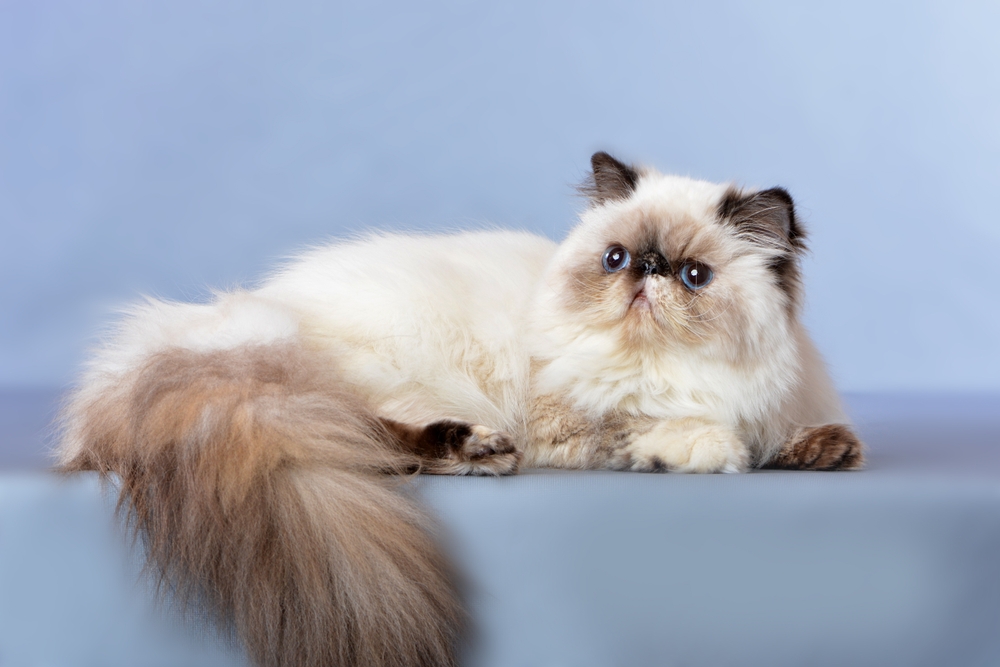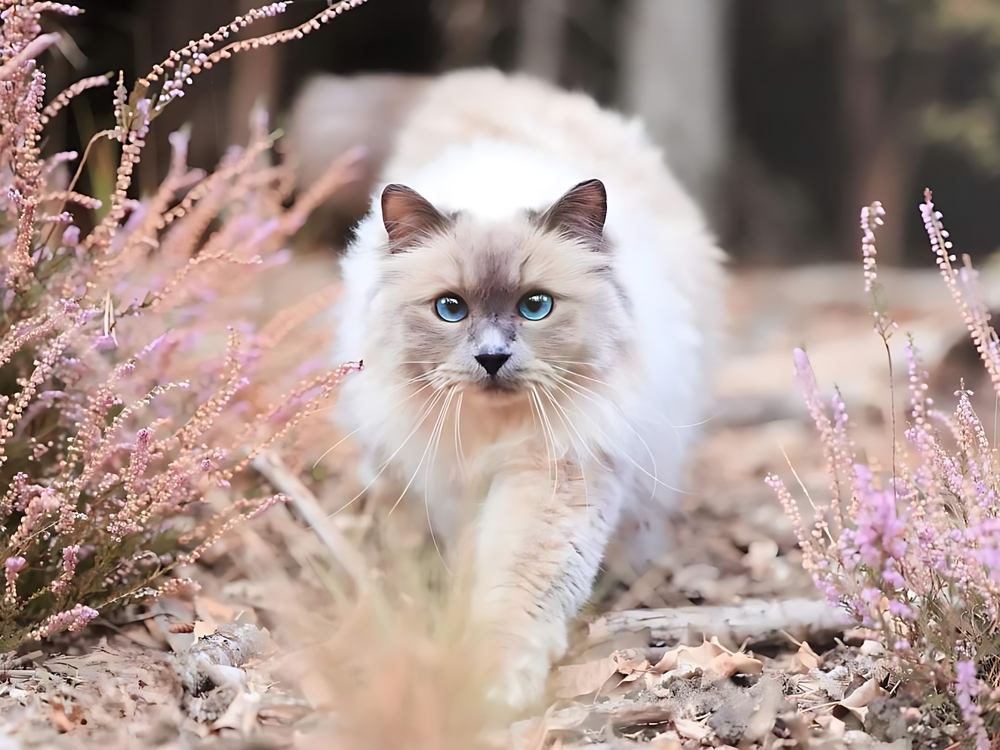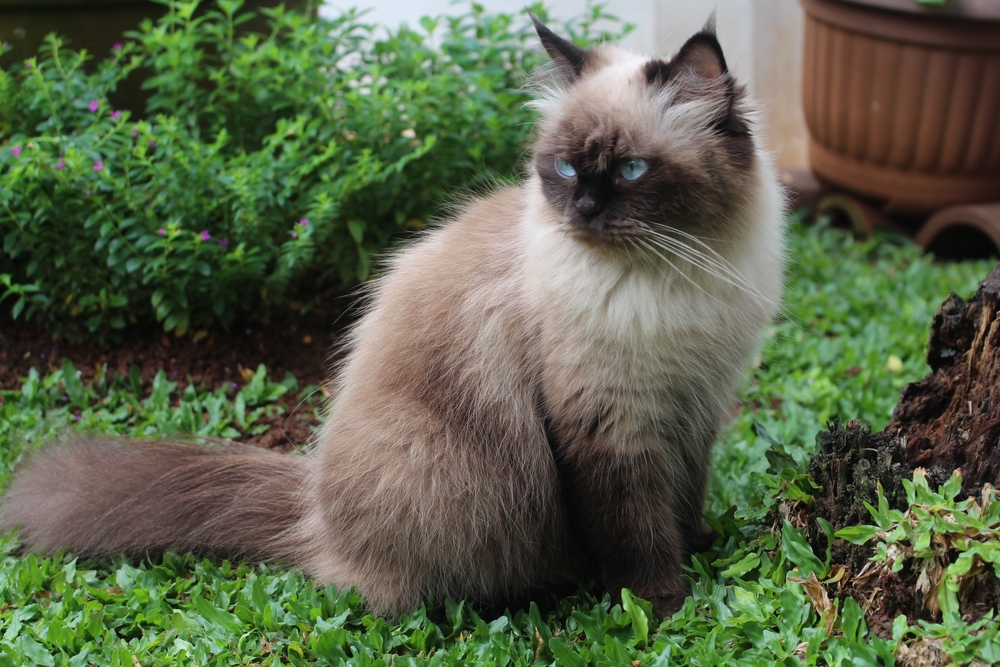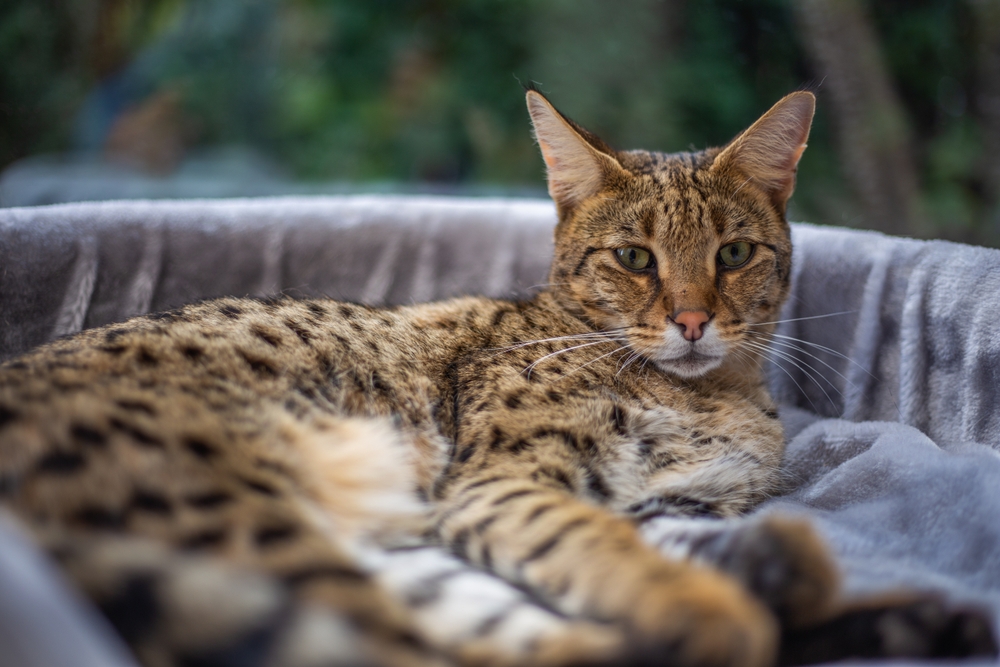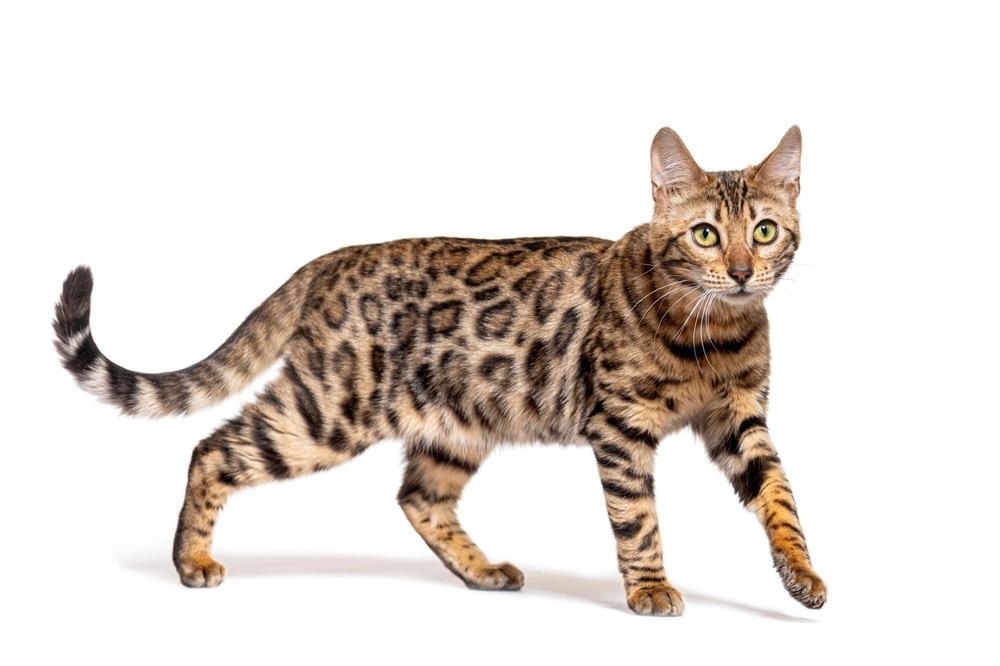The closest domestic relative is the Scottish Straight, which has the same body type and temperament but with upright ears. Other related breeds include the British Shorthair and American Shorthair, both often used in breeding programs. In the wild, the Scottish Fold’s round face and plush coat echo the European wildcat (Felis silvestris silvestris), native to Scotland and surrounding regions.
About
The Scottish Fold is a charming, medium-sized cat breed instantly recognizable for its distinctive folded ears, which give it a sweet, owl-like expression. This unique trait is caused by a natural genetic mutation that affects the cartilage, causing the ears to bend forward and downward. The breed has a rounded appearance overall, with a round head, large round eyes, and a soft, plush coat that can be short or long and comes in a wide range of colors and patterns.
The Scottish Fold (Felis catus), of the family Felidae, originated in Scotland in the 1960s when a barn cat named Susie with folded ears was discovered. Her kittens inherited the same trait, and selective breeding established the breed. The fold can vary in degree, from a single loose fold to a tight triple fold pressed close to the head. Because the gene that causes the fold is also linked to cartilage and bone issues, responsible breeding is essential to reduce the risk of skeletal conditions.
Weighing between 6–13 pounds (2.7–5.9 kg), Scottish Folds are sturdy and well-balanced. They are affectionate, gentle, and people-oriented, often following their families from room to room and happily joining in daily activities. Known for their calm and adaptable natures, they are excellent companions for households with children or other pets.
Scottish Folds require minimal grooming for shorthaired varieties, though longhaired ones benefit from weekly brushing. Regular veterinary care is particularly important due to potential joint or mobility issues linked to their genetics.
With their adorable folded ears, round features, and affectionate temperaments, Scottish Folds have become one of the most beloved cat breeds, offering both beauty and companionship to their families.
Physical Characteristics
Coat: Scottish Folds can have short or long coats. Shorthaired Folds have a dense, plush coat with a soft texture, while longhaired Folds (often called Highland Folds) have a flowing, silky coat with a full tail plume, britches, and furnishings around the ears and toes. Coat colors and patterns are highly variable, including solids, tabbies, bicolors, calicos, and pointed varieties.
Face: The most defining feature is the rounded head with prominent whisker pads, a short nose, and large, round eyes that give a sweet, owl-like expression. Eye colors vary with coat, ranging from gold and copper to green and blue.
Ears: Their hallmark trait is the folded ears, which bend forward and downward, creating a rounded, cap-like appearance. Kittens are born with straight ears, and the fold develops between 3–4 weeks of age. Some cats retain straight ears and are referred to as Scottish Straights.
Body: Medium-sized with a sturdy, rounded build. The body is well-padded, muscular, and compact without being cobby.
Tail: Medium to long, tapering, and proportionate to the body. In longhaired varieties, the tail is thickly plumed.
Size:
-
Length: 14–16 in (36–41 cm) from head to base of tail.
-
Height: 8–10 in (20–25 cm) at the shoulder.
Weight:
-
Adult Female: 6–9 lbs (2.7–4.1 kg).
-
Adult Male: 9–13 lbs (4.1–5.9 kg).
The Scottish Fold’s rounded face, wide eyes, and folded ears give it a uniquely charming, teddy b
Reproduction
Mating and Courtship:
Scottish Folds reach sexual maturity around 8–12 months, though breeders often wait until at least 12 months before breeding. Queens in heat display the usual signs—rolling, rubbing, and vocalizing—while males respond with pursuit and calling.
Breeding Considerations (Critical):
The Scottish Fold’s signature ear fold is caused by a genetic mutation affecting cartilage development. If two folded-ear cats are bred together (Fold × Fold), the kittens have a high risk of developing osteochondrodysplasia, a painful skeletal condition causing severe bone and joint deformities.
-
Responsible breeding pairs a Fold with a Straight (Scottish Straight or another outcross such as British Shorthair or American Shorthair).
-
This reduces health risks and ensures healthy, well-structured kittens.
Gestation:
Pregnancy lasts about 63–65 days (roughly 9 weeks).
Birth of Kittens:
A typical litter size is 3–5 kittens. All kittens are born with straight ears, and those that inherit the fold gene develop their distinctive ear fold between 3–4 weeks of age.
Care and Nurturing:
Kittens are born weighing about 3–4 oz (85–113 g), blind and dependent. Queens are attentive mothers, providing warmth, feeding, and grooming.
Weaning and Social Development:
-
Eyes open at 7–10 days.
-
Walking begins by 3 weeks.
-
Solid food is introduced at 4–5 weeks, with weaning completed at 8–10 weeks.
-
Social traits such as playfulness and affectionate behavior emerge early.
Independence:
By 12–14 weeks, kittens are ready for adoption, with well-developed social and physical skills. Breeders usually keep Scottish Fold kittens until at least 12 weeks to monitor ear development and ensure health.
The Scottish Fold’s reproductive cycle follows normal domestic cat patterns, but responsible breeding practices are crucial to prevent serious skeletal issues associated with the fold gene.
Lifespan
Lifespan in the Home:
Scottish Folds typically live 12–15 years, with many reaching 15–18 years when given proper care, nutrition, and veterinary attention.
Lifespan in Outdoor or High-Risk Settings:
Outdoor Folds face dangers such as traffic, predators, theft, and disease, reducing their lifespan to around 6–10 years. Their calm, trusting temperament makes them less cautious outdoors compared to some other breeds.
Factors Affecting Longevity:
-
Genetics: The fold gene is linked to osteochondrodysplasia, a cartilage and bone disorder that can cause arthritis and mobility issues. Ethical breeding (Fold × Straight) reduces risk, but monitoring for joint health is essential.
-
Weight Management: They are prone to obesity, which worsens joint strain and arthritis. A lean body condition helps extend lifespan.
-
Diet & Exercise: A high-protein diet, portion control, and interactive play maintain health and prevent weight-related problems.
-
Preventive Care: Regular vet checkups, joint monitoring, dental care, and early treatment of arthritis symptoms improve both quality and length of life.
-
Environment: Indoor living with soft bedding, ramps, and climbing structures that accommodate joint health supports long-term well-being.
Notable Longevity:
With attentive care, some Scottish Folds have lived 17–20 years, though this is less common due to their genetic health challenges.
The Scottish Fold’s lifespan depends heavily on responsible breeding and proactive health management, making ethical ownership especially important for this charming, unique breed.
Eating Habits
Diet:
Scottish Folds, like all cats, are obligate carnivores and require a protein-rich, meat-based diet. Premium commercial cat foods—wet, dry, or a balanced mix—are suitable, provided they meet AAFCO standards. Wet food supports hydration, while dry kibble helps with dental health.
Feeding Frequency:
-
Kittens (up to 6 months): 3–4 meals per day to support growth.
-
Adults (6 months–10 years): 2 meals daily, portion-controlled to prevent overeating.
-
Seniors (10+ years): Smaller, more frequent meals with senior-specific formulas to support joint and kidney health.
Special Considerations:
-
Weight Management: Scottish Folds can be prone to obesity, which worsens joint strain and arthritis risk, particularly because of their predisposition to cartilage issues. Careful portion control is essential.
-
Joint Health Support: Diets containing omega-3 fatty acids, glucosamine, and chondroitin may help support cartilage and reduce inflammation.
-
Hydration: Fresh water should always be available. Folds benefit from water fountains, which encourage drinking to support kidney and urinary health.
-
Flat Face Considerations: Some Scottish Folds with rounder, flatter faces may find shallow bowls more comfortable to eat from.
Treats:
Healthy options include freeze-dried meat or small amounts of cooked poultry or fish, but treats should make up no more than 10% of daily calories.
Feeding Enrichment:
Puzzle feeders, slow feeders, and food-dispensing toys help prevent overeating and provide mental stimulation. Gentle climbing and foraging-style feeding can encourage exercise without stressing joints.
The Scottish Fold’s eating habits reflect its gentle, food-loving nature—they thrive on high-protein, portion-controlled meals that support joint health and prevent obesity.
Uniqueness
Folded Ears:
The Scottish Fold’s defining trait is its forward-folding ears, caused by a natural genetic mutation in cartilage. This gives the breed its signature rounded, “owl-like” expression.
Owl-Like Appearance:
Large, round eyes combined with the rounded head and folded ears create a sweet, teddy bear–like look unlike any other breed.
Two Ear Types:
Not all kittens develop the fold—those with straight ears are called Scottish Straights. They share the same body and personality traits but without the folded-ear mutation.
Calm and Gentle Personality:
Scottish Folds are affectionate, adaptable, and enjoy quiet companionship. They often prefer lounging close to their humans over constant activity, making them excellent indoor pets.
Quirky Sitting Positions:
They are known for sitting in unusual positions, such as the “Buddha sit,” where they rest on their back with legs outstretched—a behavior that adds to their charm.
Health and Genetics:
The same gene responsible for folded ears can also affect cartilage and bone development, leading to potential joint and arthritis issues. This makes responsible breeding practices essential.
Modern Origins:
The breed originated in Scotland in the 1960s from a farm cat named Susie, who had naturally folded ears. Her descendants became the foundation of the breed.
The Scottish Fold’s unique ear shape, sweet appearance, calm nature, and unusual sitting habits make it one of the most distinctive and beloved cat breeds worldwide.
Be the First to Share Photos of This Species.
FAQ’s
1. What is the closest species or breed to the Scottish Fold?
2. How does the Scottish Fold compare to other cats?
Scottish Folds are more gentle, calm, and people-oriented than many breeds. Unlike active climbers such as Abyssinians or Bengals, Folds prefer lounging and quiet interaction.
Their folded ears and round faces give them a uniquely owl-like or teddy bear appearance. However, they differ from most breeds in that responsible breeding requires careful genetic pairing (Fold × Straight) to avoid skeletal issues.
3. What national parks or regions provide the best chance to see a cat resembling the Scottish Fold?
While no wildcat has folded ears, cats with similar rounded faces and stocky builds can be found in:
-
Cairngorms National Park, Scotland – Home of the Scottish wildcat, a stocky, round-faced wild feline resembling the Fold in body structure.
-
Białowieża Forest, Poland/Belarus – Habitat of the European wildcat, another close visual parallel.
-
Harz National Park, Germany – Also home to European wildcats with broad faces and plush coats.



































































